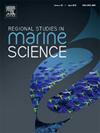阐明环境条件和营养物质在塑造孟加拉湾考克斯巴扎尔海岸浮游植物结构中的作用
IF 2.4
4区 环境科学与生态学
Q3 ECOLOGY
引用次数: 0
摘要
浮游植物群落在海洋生态系统中发挥着至关重要的作用,是环境变化的初级生产者和指标。本研究调查了孟加拉国孟加拉湾考克斯巴扎尔海岸浮游植物结构的时空变化,与环境参数(温度、盐度、pH、DO、水流)和营养动态(NO2-N、NO₃-N、NH₄-N、PO₄-P、SiO4-Si)有关。对Bakhkhali、Moheshkhali、Nunier Chara和Sonadia岛12个站点的水样进行了分析,以评估浮游植物的多样性和丰度。共鉴定出浮游植物34个属,分硅藻门、藻门、蓝藻门和绿藻门4大类,以硅藻门最占优势。典型对应分析(CCA)表明,温度和盐度是浮游植物分布的主要驱动因素,铵、磷酸盐和溶解氧是次要驱动因素。季节趋势表明,绿藻类倾向于较高的温度和动态水条件,而硅藻在低盐度环境中繁殖。Moheshkhali的海硅藻、骷髅藻和毛囊藻的优势表明初级生产力很高,而Nunier Chara的伪nitzschia丰度引起了对潜在有害藻华的担忧。这些发现强调了沿海水域浮游植物的生态意义,为可持续渔业管理和海洋生态系统保护提供了有价值的见解。本文章由计算机程序翻译,如有差异,请以英文原文为准。
Elucidating the role of environmental conditions and nutrients in shaping phytoplankton structures in the Cox’s Bazar coast, Bay of Bengal
Phytoplankton communities play a crucial role in marine ecosystems, serving as primary producers and indicators of environmental changes. This study investigates the spatial and temporal variations in phytoplankton structure along the Cox’s Bazar coast of the Bay of Bengal, Bangladesh, in relation to environmental parameters (Temperature, Salinity, pH, DO, Water Current) and nutrient dynamics (NO2-N, NO₃-N, NH₄-N, PO₄-P, SiO4-Si). Water samples from 12 stations across Bakhkhali, Moheshkhali, Nunier Chara, and Sonadia Island were analyzed to assess phytoplankton diversity and abundance. A total of 34 phytoplankton genera from four major classes—Bacillariophyceae, Dinophyceae, Cyanophyceae, and Chlorophyceae—were identified, with Bacillariophyceae being the most dominant. Canonical Correspondence Analysis (CCA) revealed that temperature and salinity were the primary drivers of phytoplankton distribution, while ammonium, phosphate, and dissolved oxygen played secondary roles. Seasonal trends indicated that Chlorophyceae preferred higher temperatures and dynamic water conditions, whereas Bacillariophyceae thrived in low salinity environments. The dominance of Thalassiosira, Skeletonema, and Chaetoceros at Moheshkhali suggested high primary productivity, while Pseudo-nitzschia abundance at Nunier Chara raised concerns about potential harmful algal blooms. The findings underscore the ecological significance of phytoplankton in coastal waters and provide valuable insights for sustainable fisheries management and marine ecosystem conservation.
求助全文
通过发布文献求助,成功后即可免费获取论文全文。
去求助
来源期刊

Regional Studies in Marine Science
Agricultural and Biological Sciences-Ecology, Evolution, Behavior and Systematics
CiteScore
3.90
自引率
4.80%
发文量
336
审稿时长
69 days
期刊介绍:
REGIONAL STUDIES IN MARINE SCIENCE will publish scientifically sound papers on regional aspects of maritime and marine resources in estuaries, coastal zones, continental shelf, the seas and oceans.
 求助内容:
求助内容: 应助结果提醒方式:
应助结果提醒方式:


